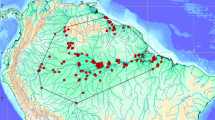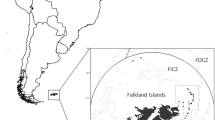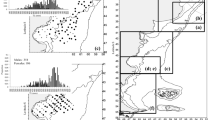Synopsis
Mature males of the sailfin molly, Poecilia latipinna (Poeciliidae), display extensive variation in size and morphology. Small males, less than about 30 mm SL, usually exhibit no distinctive color or morphological development. Large males, greater than about 45 mm SL, display full expression of the ‘sailfin’ traits, including bright blue and gold life colors, distinctive pigment markings on the fins and body, and a greatly enlarged dorsal fin. Intermediate-sized males, 30–45 mm SL, display intermediate and variable development of secondary sexual characteristics. For convenience, small, intermediate, and large males are respectively referred to as Types 1, II, and III. A multi-year analysis of four study populations in east-central Florida revealed that males did not occur in discrete classes but, instead, occurred in a size and morphological continuum. Coloration and morphological development were highly correlated with size, and the mensural traits examined displayed strong allometry. Size distributions of mature males were relatively stable at any study site over time, but there were large differences between sites. At one extreme, males at the VABI site were always relatively small (16–40 mm SL) and Type III males were absent. At the other extreme, the population at the BDGST site contained a full array of male sizes (18–60 mm SL) and Type III males were present in small numbers throughout the summer months. Regression analysis revealed only minor differences between these extreme populations in the relationship between morphological development and body size. It appears that environmental, genetic, and social factors interact in a complex and poorly understood way to control variation in male size and morphology.
Similar content being viewed by others
References cited
Baird, R.C. 1968. Aggressive behavior and social organization in Mollienesia latipinna LeSueur. Texas J. Sci. 20: 157–176.
Baird, R.C. 1974. Aspects of social behavior in Poecilia latipinna (Lesueur). Rev. Biol. Trop. 21: 399–416.
Balsano, J.S., K. Kucharski, E.J. Randle, E.M. Rasch & P.J. Monaco. 1981. Reduction of competition between bisexual and unisexual females of Poecilia in northeastern Mexico. Env. Biol. Fish. 6: 39–48.
Borowsky, R.L. 1973a. Social control of adult size in males of Xiphophorus variatus. Nature 245: 332–335.
Borowsky, R.L. 1973b. Relative size and the development of fin coloration in Xiphophorus variatus. Physiol. Zool. 46: 22–28.
Borowsky, R.L. 1978. Social inhibition of maturation in natural populations of Xiphophorus variatus (Pisces: Poeciliidae). Science 201: 933–935.
Constantz, G.D. 1975. Behavioral ecology of mating in the male Gila topminnow, Poeciliopsis occidentalis (Cyprinodontiformes: Poeciliidae). Ecology 56: 966–973.
Endler, J.A. 1980. Natural selection on color patterns in Poecilia reticulata. Evolution 34: 76–91.
Endler, J.A. 1982. Convergent and divergent effects of natural selection on color patterns in two fish faunas. Evolution 36: 178–188.
Farr, J.A. 1980. The effects of juvenile social interaction on growth rate, size and age at maturity, and adult social behavior in Girardinus metallicus Poey (Pisces: Poeciliidae). Z. Tierpsychol. 52: 247–268.
Feltkamp, C.A. & K. Kristensen. 1970. Ecology and morphological characters of different populations of Poecilia sphenops vandepolli (Cyprinodontidae). Fauna of Curacoa and Other Caribbean Islands Stud. 120: 102–130.
Gordon, H. & M. Gordon. 1954. Biometry of seven natural populations of the platyfish, Xiphophorus maculatus, from Central America. Zoologica 39: 37–59.
Hubbs, C.L. 1936. Fishes of the Yucatan Peninsula. pp. 157–287. In: A. S. Pearse, E. P. Creaser & F. G. Hall (ed.). The Cenotes of Yucatan: a Zoological and Hydrographic Survey, Carnegie Institute of Washington, Publ. 457.
Hubbs, C. L. 1942. Species and hybrids of Mollienisia. The Aquarium 10: 162–168.
Hubbs, C. L. & K. F. Lagler. 1958. Fishes of the Great Lakes region. Rev. ed., Bull. Cranbrook Inst. Sci. No. 26, Ann Arbor. 213 pp.
Kallman, K. D. 1976. Control of size in Xiphophorus pygmaeus (Poeciliidae, Pisces). Amer. Zool. 16: 260.
Kallman, K. D. 1983. The sex determining mechanism of the poeciliid fish, Xiphophorus montezumae, and the genetic control of the sexual maturation process and adult size. Copeia 1983: 755–769.
Kallman, K. D. & V. Borkoski. 1978. A sex-linked gene controlling the onset of sexual maturity in female and male platyfish (Xiphophorus maculatus), fecundity in females and adult size in males. Genetics 89: 79–119.
Kallman, K. D. & M.PP. Schreibman. 1973. A sex-linked gene controlling gonadotrop differentiation and its significance in determining the age of sexual maturation and size of the platyfish, Xiphophorus maculatus. Gen. Comp. Endocrinol. 21: 287–304.
Luckner, C. L. 1979. Morphological and behavioral polymorphism in Poecilia latipinna males (Pisces: Poeciliidae). Ph.D. Dissertation, Louisiana State University, Baton Rouge. 78 pp.
McAlister, W. H. 1958. The correlation of coloration with social rank in Gambusia hurtadoi. Ecology 39: 477–482.
McClave, J. T. & F.HH. Dietrich, II. 1982. Statistics (2nd ed.). Dellen Publ. Co., San Francisco. 766 pp.
McKay, F. E. 1971. Behavioral aspects of population dynamics in unisexual-bisexual Poeciliopsis (Pisces: Poeciliidae). Ecology 52: 778–790.
McKenzie, W. D.,Jr.,D. Crews, K. D. Kallman, D. Policansky & J. J. Sohn. 1983. Age, weight and the genetics of sexual maturation in the platyfish, Xiphophorus maculatus. Copeia 1983: 770–774.
McPhail, J. D. 1978. Sons and lovers: the functional significance of sexual dichromism in a fish, Neoheterandria tridentiger (Garman). Behaviour 64: 329–339.
Miller, R. R. 1975. Five new species of Mexican poeciliid fishes of the genera Poecilia, Gambusia, and Poeciliopsis. Occ. Pap. Mus. Zool. Univ. Mich. 672: 1–44.
Monaco, P. J., E.M. Rasch & J.S. Balsano. 1981. Sperm availability in naturally occurring bisexual-unisexual breeding complexes involving Poecilia mexicana and the gynogenetic teleost, Poecilia formosa. Env. Biol. Fish. 6: 159–166.
Peters, G. 1964. Vergleichende Untersuchungen an drei Subspecies von Xiphophorus helleri Heckel (Pisces). Z. Zool. Syst. Evolut. Forsch. 2: 185–271.
Rosen, D. E. 1960. Middle-American poeciliid fishes of the genus Xiphophorus. Bull. Florida State Mus., Biol. Sci. 5: 57–242.
Rosen, D. E. & K. D. Kallman. 1969. A new fish of the genus Xiphophorus from Guatemala, with remarks on the taxonomy of endemic forms. Amer. Mus. Novit. 2379: 1–29.
Simanek, D. E. 1978. Genetic variability and population structure of Poecilia latipinna. Nature 276: 612–614.
Snelson, F. F., Jr. 1976. A study of a diverse coastal ecosystem on the Atlantic coast of Florida: Ichthyological Studies, Vols. I and II. Final Rept., Grant NGR-10-019-004. NASA, J. F. Kennedy Space Center, FL. 407 pp.
Snelson, F. F., Jr. 1980. A continuation of base-line studies for environmentally monitoring space transportation systems at John F. Kennedy Space Center. KSC TR 51-2, Vol. III, Pt. 2. Ichthyological studies: Sailfin molly reproduction study. NASA Contract Final Rept. 163122, Kennedy Space Center, FL. 173 pp.
Snelson, F. F., Jr. 1982. Indeterminate growth in males of the sailfin molly, Poecilia latipinna. Copeia 1982: 296–304.
Snelson, F. F., Jr. 1984. Seasonal maturation and growth of males in a natural population of Poecilia latipinna. Copeia 1984: 252–255.
Snelson, F. F., Jr. & J. D. Wetherington. 1980. Sex ratio in the sailfin molly, Poecilia latipinna. Evolution 34: 308–319.
Sohn, J. J. 1977a. Socially induced inhibition of genetically determined maturation in the platyfish, Xiphophorus maculatus. Science 195: 199–201.
Sohn, J. J. 1977b. The consequences of predation and competition upon the demography of Gambusia manni (Pisces: Poeciliidae). Copeia 1977: 224–227.
Vrijenhoek, R. C. & R. J. Schultz. 1974. Evolution of a trihybrid unisexual fish (Poeciliopsis, Poeciliidae). Evolution 28: 306–319.
Zander, C. C. 1965. Die Geschlechtsbestimmung bei Xiphophorus montezumae cortezi Rosen (Pisces). Z. Vererbungsl. 96: 128–141.
Author information
Authors and Affiliations
Rights and permissions
About this article
Cite this article
Snelson, F.F. Size and morphological variation in males of the sailfin molly, Poecilia latipinna . Environ Biol Fish 13, 35–47 (1985). https://doi.org/10.1007/BF00004854
Received:
Accepted:
Issue Date:
DOI: https://doi.org/10.1007/BF00004854




